Dragon Wings
by Gary Lepak
Reprinted from Multihulls
Magazine - July/August 1999
PUFF was a magic dragon that carried our family
of four safely on many adventures... with her two bony wings
spread to the ocean winds. From Alaska to Mexico we rode on
her back and rested in her two hulls, feeling safe and comfortable
in our flights from port to port. Running down dark hallways
of water on a black stormy night in British Columbia, mountains
rising invisibly from the rocky shores on both sides, her easily
furled wings gave us the confidence to go on. Ghosting through
the drizzle of Alaska, we steered comfortably from beneath her
unfurled deck tent or huddled below by the wood stove drinking
hot cups of coffee. Surfing wing-and-wing down two-story high
hills of water at 20 knots off the coast of northern California
may have been frightening, but a drogue off the stern and sails
reefed to the last little panel kept her under control; when
darkness engulfed us, a parachute held her into the seas so
we could rest and wait for morning, to continue. She was our
home in the heat of the Sea of Cortez, her deck a shaded lounge
between the sun and the water. Rounding Point Conception and
beating back up the California coast to San Francisco, she showed
us what she was made of, seeming to revel in the 30- knot winds
and 8-foot seas.
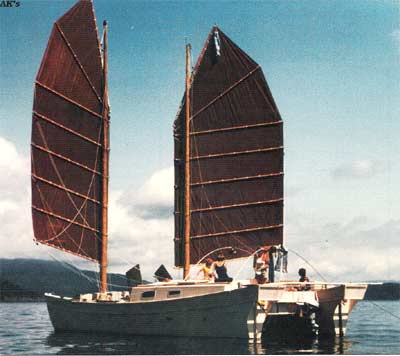
Having a weird boat does get you a lot of attention,
but it's not all flattering. We got used to the powerboats changing
course and buzzing by our stern, camera poised, even the remarks
made by curious critics in little outboards, voices raised above
the din of their motors, thinking we couldn't hear what they
were saying. It's easy to become defensive when your pride and
joy is different from the rest. Many multihull owners know all
too well the stigma associated with the odd boat. Owners of
junk-rigged boats have also seen the underside of many a yachtsman's
nose. But, a flat-sided sheet plywood, homemade, junk-rigged
catamaran with an unstayed mast in each hull? Once, in a quiet
anchorage, I was sitting down below minding my own business
when a beautiful varnished classic yacht slowly circled me.
I overheard the skipper remark to his mate, "If they gave
it to me, I'd burn it!" I restrained myself. Sometimes
the attention was more flattering. Once, drifting in a calm
in the Straits of Juan de Fuca between the US and Canada, a
300-foot Canadian warship, about a mile away, changed course
and came straight toward us, finally coming to a dead stop a
hundred yards off our stern. We stared back at the sailors who
lined the rail staring at us, but they were too far away to
talk to. After about five minutes of wondering what we had done
to warrant such attention, a voice came over their loudspeaker
and boomed out over the glassy water, "Your boat fascinates
me." Then they revved up their engines and made a right
turn leaving us laughing in the swells. During the eight years
we lived and cruised aboard PUFF we were often asked, "How
does it work?" Since I designed PUFF myself, I have no
one to blame for her faults, but I can also take credit for
her abilities. I usually just said, "It works great!"
Some were satisfied with this answer but others demanded more
details: "How does it go to windward?"
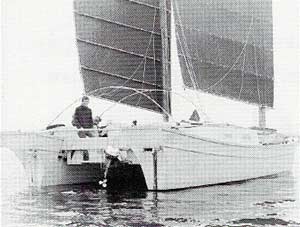
Pretty well in good wind - not so great in light
winds. This could have been helped some with a drifter, but
we never
bothered to get one - an outboard works better.
"Doesn't one sail blanket the other on a
reach?" Hardly at all. Since the sails twist very little
and there are no shrouds to chafe against, the windward sail
can be sheeted out quite a ways and still draw. By sheeting
the leeward sail in a bit more than usual, both sails are kept
drawing with the apparent wind right on the beam. The windward
sail seems to feed wind to the leeward sail.
Most people would guess it must be great downwind.
That's for sure! There is no blanketing at all downwind, and
the short, squarish sails are more efficient than tall narrow
sails on this point of sail. Unlike the catboat that suffers
from strong helm when running, our "double cat" is
almost neutral on the helm with the wind on the quarter, both
sails over to one side, and the boards raised. With the sails
out wing and wing it is completely balanced. With the tiller
unattended she'll just keep running downwind.
PUFF was designed for full-time liveaboard cruising
for a family of four. The size and shape of the hulls and the
layout of the deck was initially conceived to be the most efficient
size and shape to contain the beds, seats, storage and living
space that these four people would need. Efficiency here refers
to economical first cost, cheap and easy upkeep, and ease of
handling, more than to power-to-weight and length-to-beam ratios.
Isn't it efficient to save time and money building a boat so
you go cruising sooner with some money in your pocket? Isn't
it efficient to be able to carry a lot of food on board so you
don't have to shop in expensive ports? Isn't it efficient to
carry three dinghies so you don't have someone hollering from
the beach to come and be picked up at midnight in a stormy anchorage?
Isn't it efficient to be able to do all your hull maintenance
on beaches, between tides? Isn't it efficient to be able to
carry three windsurfers? ...well, okay, maybe not, but you have
to be able to get your speed kicks somewhere.
EVOLUTION OF THE DESIGN
Many people asked us how we came to designing and building such
a different boat.
It goes back to when we were living on our first
catamaran, Sea Urchin, a 46' Wharram Polynesian cat that we
built and launched in 1974. During the year and a half that
it took to build Sea Urchin I toyed with the idea of trying
the junk rig, which Wharram offered at the time, but finally
decided against it because Iwas afraid to try something that
I didn't know anything about. Our cutter rig was adequate, but
we didn't like getting the jib down on the bow netting, in rising
winds with cold saltwater splashing up our legs, or tying in
a reef in the main knowing that maybe in half an hour we might
want to take it out again. Also, tacking two headsails was bothersome
in the channels and fluky winds that make up 90% of the sailing
here in the Pacific Northwest. When the weather got rough, flapping
sails and whipping sheets seemed to add to our anxiety. Our
experience led us to the conclusion that with just two adults
and a young child on board, our boat should be the ultimate
in singlehanding ease. On a long passage while one parent is
sleeping, the other is responsible not only for the boat, butfor
the child as well. All these thoughts led us to consider the
Chinese rig as developed by Jock McLeod and Colonel Blondie
Hasler.
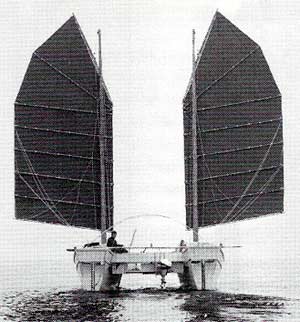
After living on our Wharram for a year, we met
a family living on a boat of the same design, but with the stayed
ketch junk rig. We became friends and sailed together for two
months, from Puget Sound in Washington, to Queen Charlotte City
in northern British Columbia. Day after day, we sailed together,
anchoring in the same place at night. It was ideal for comparison
of rigs, and we were very impressed with the Chinese rig. We
were surprised at its windward ability, especially in strong
winds, and we admired the ease with which the sails could be
reefed or unreefed.
We made our tirst offshore passage from the Queen
Charlotte Islands to California, and I started trying to design
"the next boat," that would, I hoped, incorporate
the junk rig. I especially liked the unstayed version that I
had read about, because there was no chafe of the yard against
the shrouds, and the sails could be sheeted out farther. I thought
a trimaran or monohull were the only possibilities for this
rig because the masts have to be stepped in a hull to have enough
"bury" to be self supporting. I sketched quite a few
possibilities but none of them excited us too much. We had become
attached to
the center deck space and the separate cabins of the Wharram
and didn't want to give those things up.
One night, in SanDiego, while talking boat design
with a monohull friend, he asked why "catamaran people"
never put one mast in each hull. I explained that it had been
tried but never really caught on - too expensive, complicated,
narrow staying angles, etc. I knew there must be some reason.
But it got me to thinking, and I realized that with the unstayed
rig there wouldn't be any staying problem, and that the full-battened
lug rig could be made economically ... at home. I sketched some
catamaran designs with shorter, fatter hulls to give us the
accommodations we wanted in a size we could afford, and one
unstayed mast in each hull. The new boat would be between 30
and 36 feet long. It was designed to fit our personal needs:
a liveaboard cruiser for a family of three,
soon to be four.
We tried to sell our Wharram in California but
didn't have any success, so we decided to go to Hawaii. We wanted
to make a "real" ocean passage, see Hawaii and, hopefully,
sell our boat so that we could build our new dreamboat. Seventeen
days at sea brought us into Hilo. I got a job; we stayed on
the Big Island for most of a year; our daughter was born; we
got new sails; butwe didn't sell the boat. So, we sailed for
Lahaina on Maui and there we sold our Wharram. She had been
our home for over four years, and we were sad to leave her,
but it was time for us to try something new.
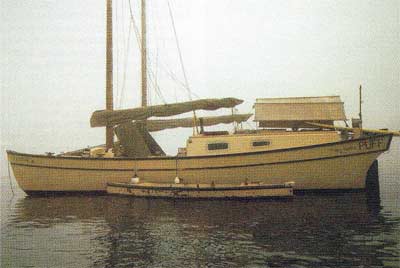
The time of decision had arrived. Did we really
have the nerve to build that crazy boat with the junk sail on
each hull? Wouldn't it be more prudent to build an existing
design, one that would be sure to work and have good resale
value? I had many misgivings, for sure, but my wife, Joanne,
knew that if we never built it, I would forever be a frustrated
designer, afraid to try something new. She encouraged me to
give it a go. We told ourselves, over and over, all the reasons
why it would work, and a few of the reasons why it might not.
And we figured that if it was a complete disaster we could change
the rig and keep the hulls. So, with our life's savings in-hand
we boarded a jet and headed back to where we had started from
four years
earlier: Seattle.
Having money to build a boat is a lot nicer than
wanting to build a boat and not having any money. The second
time around (years before I promised myself there would never
be a second time) was easier on that point; we mainly had to
worry about getting the boat built, not about making money.
But material cost had gone up more than we realized.
Joanne had to work, now and then, to stretch
the funds out to launching. Also, designing and building is
a lot slower than building from plans. Every detail and all
its consequences must be thought out before you pick up the
saw. We were lucky to discover that Jock McLeod was selling
instructions on how to build the junk rig. We used his excellent
material for designing and building our rig, and I'm sure it
saved us a lot of time and mistakes. The edges of the Chinese
sail are straight, so there is no trick to cutting them.
There is, however, a lot oflabor involved in
making them because of the battens. Anyone who can sew straight
should be able to make a decent junk sail. We made our own,
and they came out quite good.
Our masts were solid grown sticks of Douglas
fir purchased from a yard that supplies utility poles. They
were 35 feet long and cost $85 each (in 1979).
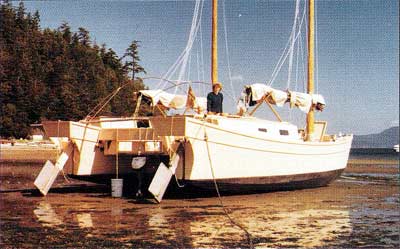
Since there are no tangs, chainplates, turnbuckles,
wire, or winches, the rig is quite economical to put together,
especially if you make your own sails. The halyards, sheets
and lazy jacks call for more line and blocks than usual, but
the total cost is still very much below the usual modern Bermudan
rig with all its wire and winches.
In keeping with the economy of the rig, the hulls
were designed to be built as economically as possible. They
were single chine, V-bottom hulls of sheet plywood and epoxy
with a laminated keel over ply and fir frames and stringers.
The crossbeams were hollow boxes connected to the hulls with
mild steel galvanized fittings, cushioned with rubber (from
old tires) to allow some independent movement and demountability.
The cockpit and centerdeck were suspended from the crossbeams,
independent ofthe hulls so as not to interfere with flexing.
The cockpit seats were, in effect, 12' fore-and-aft box beams
that support the cockpit sole and serve as storage lockers.
An outboard motor swung up in the middle of the cockpit.
The hulls drew only 18", so boards were
needed to prevent leeway. We decided to use dagger-leeboards
on the inboard sides ofthe hulls. They were tied down at deck
level and swung up part way when grounding. Since they were
held against the hull with a steel strap above the waterline,
one board worked on both tacks. They weren't the most efficient
but they didn't take up interior space and they were easy to
maintain. With such shallow draft, the rudders must be deeper
than the hulls. We used kick-up skeg rudders, held by a line
designed to break loose when grounding, allowing the unit to
pivot upwards. They could be pulled halfway up for sailing in
shallow water, or all the way up when anchored for any length
of time.
Each hull had a 12- foot-long cabin behind the
center crossbeam and a double bunk forward. Forward of the mast
was a watertight bulkhead and storage area. The arched tubes
that spanned the cockpit supported a tarp that could be rolled
out for protection from rain or sun, and covered the main cabin
hatches, making it a lot more pleasant to go from one hull to
the other on a dark rainy night. Since we didn't have any head
sails to handle, we eliminated the forward netting on this boat,
allowing us to drop and haul up anchors right from where they
are stored behind the forward crossbeam. On the flat deckspace
forward of the cabins we carried a 16- foot rowboat and a 7
-foot pram, along with 2 or 3 windsurfers.
THE RIG
A year and a half after drawing the lines, Dragon Wings number
one, Puff, was ready to be launched. April Fools Day, 1980 -
we hoped we weren't the fools, but we would soon know. She floated
well. A month after launching the rig was finished and we went
for our first sail. She wouldn't point as high, or go as fast
close-hauled as a sloop, but she got us where we wanted to go
with style and ease. Although a ghoster set flying would help
the windward performance in light winds, we never felt it was
important enough to get one.
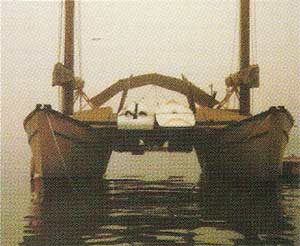
After a few sails we got used to handling the
rig (don't pinch or sheet it in too tight) and realized that
it was basically a success. Whew!
The more we sailed, the more we liked it. It
was so easy to make or furl sail that "going for a sail"
became much less of a job than it had been with our cutter rig.
The lazy jacks caught the battens when the sail was lowered,
the excess sheet pulled in, and that's all there was to it-no
hanks, bags or ties. Put on the sail covers and you're done.
Tacking was a one-man, one-hand operation: push the tiller over
and she came about.
If you messed up, you could back the leeward
sail as you would a jib, but after a bit of practice this was
rare. To reef, or lower the sail the desired number of battens,
tie the lowest one down with the downhaul by the mast, and take
in the slack on the line that holds the yard to the mast. There
are no reefties because the batten holds the sail down and the
sheet holds the aft end of the batten down. The sails never
flap when luffed up, but are always docile and quiet. It is
also possible to raise, lower, or reef the sail on any point
of sail.
Dragon Wings was designed for comfortable living
aboard and cruising. She was not a high-speed boat because of
her wide, 7.5 to 1,length-to-beam ratio hulls. She'd do just
8 knots in protected waters, but she'd surf with the best of
them in the ocean when the seas were 8' or more. I'm sure we
hit 20 knots on 20' seas. She's certainly not the type of boat
for someone who can't stand being passed by another boat - most
boats passed her to windward, especially in light airs - but
downwind she'd pass almost anyone not flying a spinnaker. Since
she's meant mainly for ocean cruising, I think the downwind
efficiency and ease of handling are very important. It's rare
that any cruiser makes a passage dead to windward, no matter
how good the boat is on that point of sail, yet downwind ability
is usually "added on" after the rig has been designed
to go to windward. The result is awkward and hard-to-handle
spinnakers, whisker poles, and running twin jibs that can only
be used downwind. On Dragon Wings we used the same sails all
the time and had no sails to store below.
The Chinese rig gybes very easily. The boom is
just another batten, so it doesn't threaten heads too much.
Since there is little twist in the sail and no shrouds, the
sail can be let out all the way when running, so an accidental
gybe is rare
The sheets and sails are over the hulls away from the cockpit,
so in a gybe no one is in the way of the sail. In an intentional
gybe the boat can be brought on to the opposite tack before
the sail starts to swing over, so when it comes to rest on the
new tack, it has lost its momentum and doesn't jerk the sheets.
We lived aboard PUFFfor eight years, cruising
from Alaska to Mexico and have many wonderful memories of those
years. She lived up to our expectations in always being easy
to handle, safe, and comfortable. We were glad that we took
the gamble and tried something different and that when asked
that eternal question, we could always answer,
"Yes, she works great!"
July/August 1999. MULTIHULLS
Magazine


